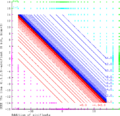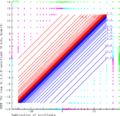Minifloat
In computing, minifloats are floating-point values represented with very few bits. This reduced precision makes them ill-suited for general-purpose numerical calculations, but they are useful for special purposes such as:
Additionally, they are frequently encountered as a pedagogical tool in computer-science courses to demonstrate the properties and structures of floating-point arithmetic and IEEE 754 numbers. Depending on context minifloat may mean any size less than 32, any size less or equal to 16, or any size less than 16. The term microfloat may mean any size less or equal to 8.[3] NotationThis page uses the notation (S.E.M) to describe a mini float:
Minifloats can be designed following the principles of the IEEE 754 standard. Almost all use the smallest exponent for subnormal and normal numbers. Many use the largest exponent for infinity and NaN, indicated by (special exponent) SE = 1. Some mini floats use this exponent value normally, in which case SE = 0. The exponent bias B = 2E-1 - SE. This value insures that all representable numbers have a representable reciprocal. The notation can be converted to a (B,P,L,U) format as (2, M + 1, SE - 2E-1 + 1, 2E-1 - 1). UsageThe Radeon R300 and R420 GPUs used an "fp24" floating-point format (1.7.16).[4] "Full Precision" in Direct3D 9.0 is a proprietary 24-bit floating-point format. Microsoft's D3D9 (Shader Model 2.0) graphics API initially supported both FP24 (as in ATI's R300 chip) and FP32 (as in Nvidia's NV30 chip) as "Full Precision", as well as FP16 as "Partial Precision" for vertex and pixel shader calculations performed by the graphics hardware. Minifloats are also commonly used in embedded devices such as microcontrollers where floating-point will need to be emulated in software. To speed up the computation, the mantissa typically occupies exactly half of the bits, so the register boundary automatically addresses the parts without shifting (ie (1.3.4) on 4-bit devices).[citation needed] The bfloat16 (1.8.7) format is the first 16 bits of a single-precision number and was often used in image processing and machine learning before hardware support was added for other formats. The IEEE 754-2008 revision has 16-bit (1.5.10) floats called "half-precision" (opposed to 32-bit single and 64-bit double precision). In 2016 Khronos defined 10-bit (0.5.5) and 11-bit (0.5.6) unsigned formats for use with Vulkan.[5][6] These can be converted from positive half-precision by truncating the sign and trailing digits. In 2022 NVidia and others announced support for "fp8" format (1.5.2).[2] These can be converted from half-precision by truncating the trailing digits. Since 2023, IEEE SA Working Group P3109 is working on a standard for 8-bit minifloats optimized for machine learning. The current draft defines not one format, but a family of 7 different formats, named "binary8pP", where "P" is a number from 1 to 7 and the bit pattern is (1.8-P.P-1). These also have SE=0 and use the largest value as Infinity and the pattern for negative zero as NaN.[7][2] Also since 2023, 4-bit (1.2.1) floating point numbers — without the four special IEEE values — have found use in accelerating large language models.[8][9]
Examples8-bit(1.4.3)A minifloat in 1 byte (8 bit) with 1 sign bit, 4 exponent bits and 3 significand bits (1.4.3) is demonstrated here. The exponent bias is defined as 7 to center the values around 1 to match other IEEE 754 floats[10][11] so (for most values) the actual multiplier for exponent x is 2x−7. All IEEE 754 principles should be valid.[12] This form is quite common for instruction.[citation needed]
Zero is represented as zero exponent with a zero mantissa. The zero exponent means zero is a subnormal number with a leading "0." prefix, and with the zero mantissa all bits after the decimal point are zero, meaning this value is interpreted as . Floating point numbers use a signed zero, so is also available and is equal to positive . 0 0000 000 = 0 1 0000 000 = −0 For the lowest exponent the significand is extended with "0." and the exponent value is treated as 1 higher like the least normalized number: 0 0000 001 = 0.0012 × 21 - 7 = 0.125 × 2−6 = 0.001953125 (least subnormal number) ... 0 0000 111 = 0.1112 × 21 - 7 = 0.875 × 2−6 = 0.013671875 (greatest subnormal number) All other exponents the significand is extended with "1.": 0 0001 000 = 1.0002 × 21 - 7 = 1 × 2−6 = 0.015625 (least normalized number) 0 0001 001 = 1.0012 × 21 - 7 = 1.125 × 2−6 = 0.017578125 ... 0 0111 000 = 1.0002 × 27 - 7 = 1 × 20 = 1 0 0111 001 = 1.0012 × 27 - 7 = 1.125 × 20 = 1.125 (least value above 1) ... 0 1110 000 = 1.0002 × 214 - 7 = 1.000 × 27 = 128 0 1110 001 = 1.0012 × 214 - 7 = 1.125 × 27 = 144 ... 0 1110 110 = 1.1102 × 214 - 7 = 1.750 × 27 = 224 0 1110 111 = 1.1112 × 214 - 7 = 1.875 × 27 = 240 (greatest normalized number) Infinity values have the highest exponent, with the mantissa set to zero. The sign bit can be either positive or negative. 0 1111 000 = +infinity 1 1111 000 = −infinity NaN values have the highest exponent, with the mantissa non-zero. s 1111 mmm = NaN (if mmm ≠ 000) This is a chart of all possible values for this example 8-bit float:
There are only 242 different non-NaN values (if +0 and −0 are regarded as different), because 14 of the bit patterns represent NaNs. 8-bit (1.4.3) with B = -2At these small sizes other bias values may be interesting, for instance a bias of −2 will make the numbers 0–16 have the same bit representation as the integers 0–16, with the loss that no non-integer values can be represented. 0 0000 000 = 0.0002 × 21 - (-2) = 0.0 × 23 = 0 (subnormal number) 0 0000 001 = 0.0012 × 21 - (-2) = 0.125 × 23 = 1 (subnormal number) 0 0000 111 = 0.1112 × 21 - (-2) = 0.875 × 23 = 7 (subnormal number) 0 0001 000 = 1.0002 × 21 - (-2) = 1.000 × 23 = 8 (normalized number) 0 0001 111 = 1.1112 × 21 - (-2) = 1.875 × 23 = 15 (normalized number) 0 0010 000 = 1.0002 × 22 - (-2) = 1.000 × 24 = 16 (normalized number) 8-bit (1.3.4)Any bit allocation is possible. A format could choose to give more of the bits to the exponent if they need more dynamic range with less precision, or give more of the bits to the significand if they need more precision with less dynamic range. At the extreme, it is possible to allocate all bits to the exponent (1.7.0), or all but one of the bits to the significand (1.1.6), leaving the exponent with only one bit. The exponent must be given at least one bit, or else it no longer makes sense as a float, it just becomes a signed number. Here is a chart of all possible values for (1.3.4). M ≥ 2E-1 ensures that the precision remains at least 0.5 throughout the entire range.[13]
Tables like the above can be generated for any combination of SEMB (sign, exponent, mantissa/significand, and bias) values using a script in Python or in GDScript. 6-bit (1.3.2)With only 64 values, it is possible to plot all the values in a diagram, which can be instructive. These graphics demonstrates math of two 6-bit (1.3.2)-minifloats, following the rules of IEEE 754 exactly. Green X's are NaN results, Cyan X's are +Infinity results, Magenta X's are -Infinity results. The range of the finite results is filled with curves joining equal values, blue for positive and red for negative.
4 bit (1.2.1)The smallest possible float size that follows all IEEE principles, including normalized numbers, subnormal numbers, signed zero, signed infinity, and multiple NaN values, is a 4-bit float with 1-bit sign, 2-bit exponent, and 1-bit mantissa.[14]
3-bit (1.1.1)If normalized numbers are not required, the size can be reduced to 3-bit by reducing the exponent down to 1.
(0.2.1) and (0.1.1)In situations where the sign bit can be excluded, each of the above examples can be reduced by 1 bit further, keeping only the first row of the above tables. A 2-bit float with 1-bit exponent and 1-bit mantissa would only have 0, 1, Inf, NaN values. 1-bit (0.1.0)Removing the mantissa would allow only two values: 0 and Inf. Removing the exponent does not work, the above formulae produce 0 and sqrt(2)/2. The exponent must be at least 1 bit or else it no longer makes sense as a float (it would just be a signed number). See also
References
External links
|
|||||||||||||||||||||||||||||||||||||||||||||||||||||||||||||||||||||||||||||||||||||||||||||||||||||||||||||||||||||||||||||||||||||||||||||||||||||||||||||||||||||||||||||||||||||||||||||||||||||||||||||||||||||||||||||||||||||||||||||||||||||||||||||||||||||||||||||||||||||||||||||||||||||||||||||||||||||||||||||||||||||||||||||||||||||||||||||||||||||||||||||||||||||||||||||||||||||||||||||||||||||||||||||||||||||||||||||||||||||||||||||||||||||||||||||||||||||||||||||||||||||||||||||||||||||||||||||||||||||||||||||||||||||||||||||||||||||||||||||||||||||||||||||||||||||||||||||||||||||||||||||||||||||||||||||||||||||||||||||||||||||||||||||||||||||||||||||||||||||||||||||||||||
Portal di Ensiklopedia Dunia
























